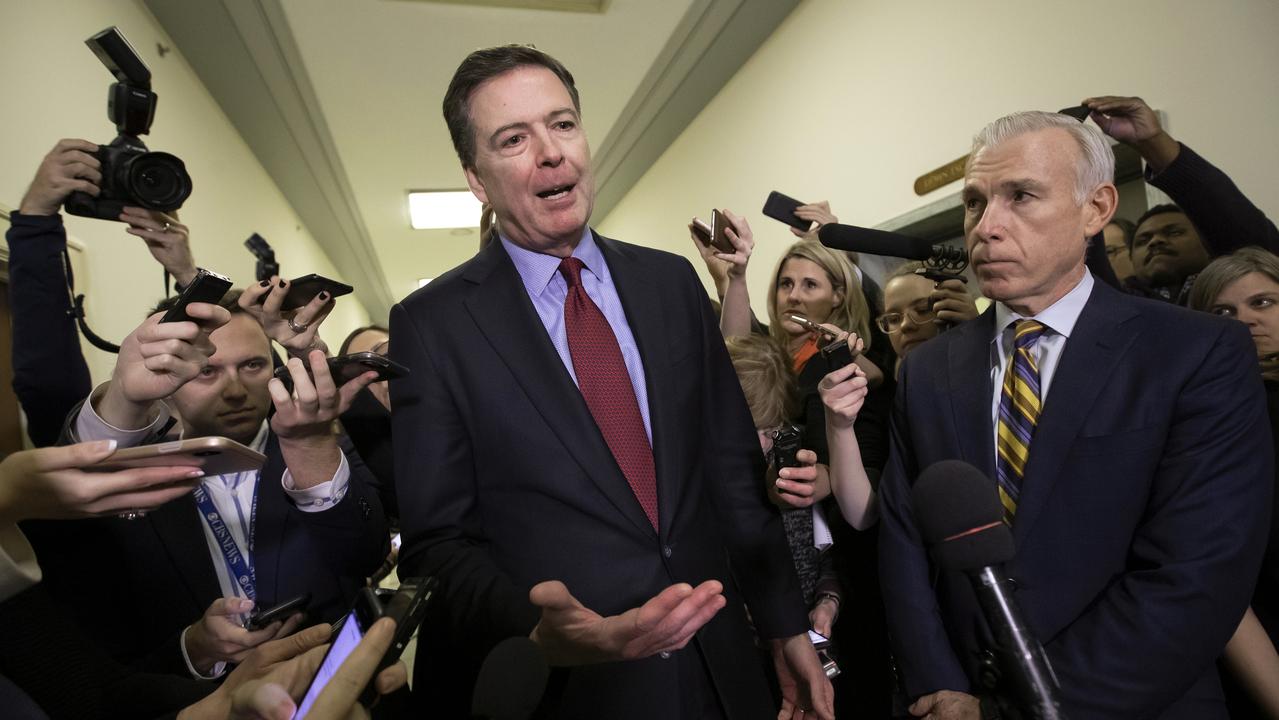BoM’s heated argument over temperatures
Warring groups are blurring the lines on the climate and weather debate.

Australia’s “record warm winter” is heading for another “sizzling summer” towards a truly “scary century” in which experts warn Sydney and Melbourne temperatures may top 50C.
A relentless rise in temperatures is being documented forensically by the nation’s peak weather agency, the Bureau of Meteorology.
Official concerns are taken up by advocacy groups that use volunteers to amplify the message and make it go viral on social media. Weather porn is clickbait gold for websites as temperature records continue to tumble.
“Record after record is being broken,” Australian Greens leader Richard Di Natale said on the ABC’s Q&A on Monday. Early bushfires in NSW were presented as evidence the Adani coalmine in Queensland would kill the Great Barrier Reef.
A busy Caribbean cyclone season is claimed as climate change despite a decade-long lull in landfall cyclones that proceeded it.
Former prime minister Tony Abbott provoked uproar with a speech in London yesterday that said there was never a time to stop asking questions and asking for proof. “There is almost nothing important where no further inquiry is needed,” Abbott said.
His scepticism was upfront. “Contrary to the breathless assertions that climate change is behind every weather event, in Australia, the floods are not bigger, the bushfires are not worse, the droughts are not deeper or longer, and the cyclones are not more severe than they were in the 1800s,” he said.
“It may be that a tipping point will be reached soon and the world might start to warm rapidly, but so far reality has stubbornly refused to conform to the Intergovernmental Panel on Climate Change’s computer modelling.”
Despite claims of scientific consensus, communities remain split between those who are sure the world is going to hell in a fiery handbasket unless there is a wholesale and immediate switch from fossil fuels to renewable energy, on the one hand, and others who struggle to match the message with official observations.
Predictions of a snowless future just got dumped in fresh powder on the Australian Alps.
The more than decade-long slowdown in global temperature rises at the turn of the century is now widely accepted as scientific fact, and mostly explained by natural variation.
For every claim of a record hot winter’s day, there is anecdotal evidence of a cold pensioner unable to afford their power bill.
Along the way the lines between weather and climate have been blurred.
A new branch of climate science gives odds of how likely an extreme event would have been with or without human impact on climate.
“Climate change had made Australia’s warmest winter on record an astounding 60 times more likely,” says Australia’s Tim Flannery-led Climate Council.
US climate scientist Judith Curry says she considers model-based attribution arguments as “voodoo statistics”.
Meanwhile, the weather bureau is being called on to defend its records and methods against passionate critics it would rather dismiss as “amateurs”.
BoM chief executive Andrew Johnson has agreed to meet with leading critic Jennifer Marohasy, who has accused the bureau of putting in place “a measurement system guaranteed to provide new record high and low temperatures”.
In a letter to federal Environment and Energy Minister Josh Frydenberg, Marohasy says “While the bureau’s temperature data underpins the theory of human-caused global warming with far-reaching economic policy consequences, there is no evidence to suggest that the bureau has been providing anything but a biased picture of climate change since the 1990s, when automatic weather stations were installed across Australia.”

The bureau rejects the criticisms and says a review of the automatic weather stations network, which included three independent experts, found BoM’s equipment, verification process, quality checks and processes for finding and acting on equipment failure were sound.
“Notwithstanding, the review found that there were failures in some of the bureau’s internal processes dating back to the mid-1990s,” BoM says. “Inadequate communication meant that hardware, unsuitable at very low temperatures, was inadvertently installed during repairs.”
BoM has been diligent in documenting how temperatures in Australia have been getting hotter.
A snapshot of the bureau’s special climate statements tells the story. In a report on the “exceptional September”, the BoM says that on September 22 Australia had its warmest September day since national area-averaged temperature records began in 1911.
In the following week, NSW and Queensland had their warmest September days on record. From September 23 to 29, 31 out of 62 of the national temperature record stations, known as ACORN-SAT, had recorded their hottest September day on record.
Release of the September statement coincided with publication of a paper by Australian National University researchers that says Melbourne and Sydney should prepare for 50C days under the Paris Agreement global warming limit of 2C.
In an ANU statement, lead researcher Sophie Lewis says: “Our climate modelling has projected daily temperatures of up to 3.8C above existing records in Victoria and NSW, despite the ambitious Paris efforts to curb warming.
“Urgent action on climate change is critical — the severity of possible future temperature extremes simulated by climate models in this study poses serious challenges for our preparedness for future climate change in Australia.’’
The actual paper is more measured. “While insights into the timing of such extremes likely depends on the validity of the models used here, such unprecedented temperatures would present onerous challenges to human and natural systems,’’ it says.
“This study provides broad guidance about the magnitude of plausible extreme events in various future warming scenarios.”
But “precise values of extremes simulated by models should not, however, be interpreted prescriptively”.
The paper has fed into the long-running and escalating row between Marohasy and BoM over the quality of the bureau’s data-handling because it relies on model data that has already been adjusted.
Marohasy wants evidence the shift to automatic weather stations has not compromised the temperature record. She now says BoM may not have been recording temperatures from its automatic weather stations in a way consistent with World Meteorological Organisation guidelines, which the bureau rejects.
Marohasy says it is “generally understood that all sub-minute recordings from electronic probes (platinum resistance thermometers) are averaged over at least one minute”.
Data loggers at the bureau’s official automatic weather stations were “only taking spot readings — one-second recordings every minute, with no averaging”, she adds.
Marohasy says this puts a cloud over whether BoM’s automatic weather station data set meets WMO standards.
BoM has defended its automatic weather station equipment.
It tells The Australian: “The temperature sensor itself is an averaging or integrating device.
“The response time of the sensor is as long or longer than the changes in the temperature of air it is measuring.
“This means that each measurement — ie the ‘one-second temperature values’ referred to in the Review of the Bureau of Meteorology’s Automatic Weather Stations — is not an instantaneous measurement of the air temperature but an average of the previous 40 to 80 seconds.
“This process is comparable to the observation process of an observer using a mercury-in-glass thermometer.”
Marohasy wants proof. And she has support from the highest level of government for BoM’s co-operation to test whether the temperature measurements are comparable.
There are many who believe the work of the bureau should be out of bounds for questioning.
Former BoM chief executive Rob Vertessy has been highly critical of what he describes as a motivated group of “amateurs”.
“From my perspective, people like this, running interference on the national weather agency, are unproductive and it’s actually dangerous,” Vertessy told Guardian Australia in response to reports in The Australian.
“Every minute a BoM executive spends on this nonsense is a minute lost to managing risk and protecting the community.
“Time and time again there has been one independent review by experts after another, all telling the same story.
“The simple, unimpeachable facts are that the BoM is doing an exemplary job at managing the nation’s climate data, and multiple independent reviews have confirmed that, and we are recognised by our World Meteorological Organisation peers as being among the best in the world.
“That keeps being restated and restated.”
What Vertessy does not say is that an independent review of BoM’s homogenisation process and ACORN-SAT has been recommended by a peer review study but the recommendation was not acted on until the bureau was pressured to do so by media attention.
The expert panel praised BoM’s work and said homogenisation was necessary but it recommended changes, including greater transparency in data-handling and to work with expert statisticians to quantify “error margins” or the level of certainty in adjusted data, which BoM has yet to do.
With the three-year review complete, BoM will release an updated version of ACORN-SAT later this year.
The specific complaints made in writing to the technical oversight panel, which sparked the independent review, were not investigated.
Now, under direction from Frydenberg, Johnson has agreed to meet Marohasy to discuss her continuing concerns.
Marohasy wants the bureau to release comparative data from old-style thermometers and more modern electronic sensors that were run in parallel during the changeover at one site.
Johnson has agreed to meet Marohasy and says the bureau does its best to “collaborate on research projects that advance the national interest and are aligned with our priorities and capabilities”.
“Accordingly, I will make further inquiries with my team, noting the potential resourcing and policy matters mentioned above and our singular focus on public safety over the next months as the severe weather season ramps up,” Johnson says.
Marohasy says she has subsequently been assured that the parallel data to enable a fair comparison of temperature measurements from electronic probes and mercury thermometers will be made available.
Whatever happens, it is shaping up as another angry summer, at least for the Bureau of Meteorology.





To join the conversation, please log in. Don't have an account? Register
Join the conversation, you are commenting as Logout